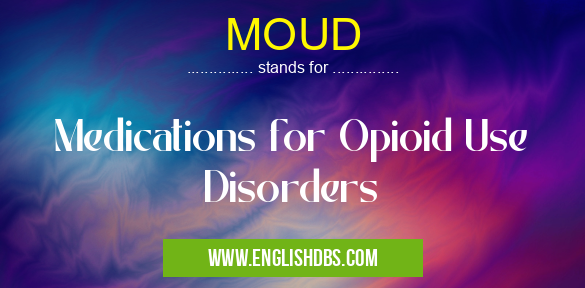What does MOUD mean in MEDICAL
MOUD stands for Medications for Opioid Use Disorders. These medications are used to treat opioid addiction and dependence by reducing cravings and withdrawal symptoms. They work by binding to opioid receptors in the brain, blocking the effects of opioids and reducing the desire to use them.

MOUD meaning in Medical in Medical
MOUD mostly used in an acronym Medical in Category Medical that means Medications for Opioid Use Disorders
Shorthand: MOUD,
Full Form: Medications for Opioid Use Disorders
For more information of "Medications for Opioid Use Disorders", see the section below.
Types of MOUD
- Methadone: A long-acting opioid that is taken orally once or twice daily. It is the most commonly used MOUD.
- Buprenorphine: A partial opioid agonist that is taken sublingually or buccally. It has a lower risk of overdose than methadone.
- Naltrexone: An opioid antagonist that is taken orally or by injection. It blocks the effects of opioids and can prevent relapse.
Benefits of MOUD
- Reduces cravings: MOUD can significantly reduce cravings for opioids, making it easier for individuals to stay abstinent.
- Prevents overdose: By blocking the effects of opioids, MOUD can prevent overdose deaths.
- Improves physical and mental health: Opioid addiction can damage physical and mental health. MOUD can help restore health and well-being.
- Increases social functioning: MOUD can help individuals return to work, school, and other social activities.
Essential Questions and Answers on Medications for Opioid Use Disorders in "MEDICAL»MEDICAL"
What are Medications for Opioid Use Disorders (MOUD)?
MOUD are medications that can help reduce opioid cravings and withdrawal symptoms, and improve overall functioning for people with opioid use disorder. They include buprenorphine, methadone, and naltrexone.
How do MOUD work?
MOUD work by binding to opioid receptors in the brain and producing partial or full effects, depending on the medication. This helps to reduce cravings, prevent withdrawal symptoms, and minimize the euphoric effects of opioids.
Who can benefit from MOUD?
MOUD can benefit adults who have opioid use disorder and are motivated to quit or reduce their use. They are particularly effective for people who have tried other treatments without success.
What are the different types of MOUD?
The three main types of MOUD are:
- Buprenorphine: A partial opioid agonist that binds to opioid receptors and produces partial effects, reducing cravings and withdrawal symptoms.
- Methadone: A full opioid agonist that binds to opioid receptors and produces full effects, preventing withdrawal symptoms and cravings.
- Naltrexone: An opioid antagonist that blocks opioid receptors, preventing the euphoric effects of opioids and reducing cravings.
How are MOUD administered?
MOUD can be administered in various ways, including:
- Tablets
- Injections
- Under the tongue
- Implants
- **Films
Are MOUD safe?
MOUD are generally safe and well-tolerated when used as prescribed. However, they can have side effects, such as nausea, vomiting, constipation, and drowsiness. It is important to take MOUD under the supervision of a healthcare professional.
Final Words: MOUD are essential tools in the treatment of opioid use disorders. They can help individuals achieve and maintain recovery by reducing cravings, preventing overdose, and improving overall health and well-being.
